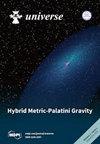Mono-Higgs and Mono-Z Production in the Minimal Vector Dark Matter Model
IF 2.5
4区 物理与天体物理
Q2 ASTRONOMY & ASTROPHYSICS
引用次数: 0
Abstract
The minimal vector dark matter is a viable realization of the minimal dark matter paradigm. It extends the standard model by the inclusion of a vector matter field in the adjoint representation of SU(2)L. The dark matter candidate corresponds to the neutral component of the new vector field (V0). Previous studies have shown that the model can explain the observed dark matter abundance while evading direct and indirect searches. At colliders, the attention has been put on the production of the charged companions of the dark matter candidate. In this work, we focus on the mono-Higgs and mono-Z signals at Hadron colliders. The new charged vectors (V±) are invisible unless a dedicated search is performed. Consequently, we assume that the mono-Higgs and mono-Z processes correspond to the pp→hV+,0V−,0 and pp→ZV+,0V−,0 reactions, respectively. We show that, while the pp→hV+,0V−,0 is more important, both channels may produce significant signals at the HL-LHC and colliders running at s=27 TeV and 100 TeV, probing almost the complete parameter space.最小矢量暗物质模型中的单希格斯和单Z生产
最小矢量暗物质是最小暗物质范式的一种可行实现方式。它通过在 SU(2)L 的邻接表示中加入一个矢量物质场来扩展标准模型。暗物质候选者对应于新矢量场(V0)的中性分量。先前的研究表明,该模型可以解释观测到的暗物质丰度,同时躲避直接和间接搜索。在对撞机上,人们一直关注暗物质候选者带电伴星的产生。在这项工作中,我们重点研究了强子对撞机上的单希格斯和单Z信号。新的带电矢量(V±)是不可见的,除非进行专门的搜索。因此,我们假定单希格斯和单Z过程分别对应于pp→hV+,0V-,0和pp→ZV+,0V-,0反应。我们的研究表明,虽然pp→hV+,0V-,0反应更为重要,但在HL-LHC和运行在s=27 TeV和100 TeV的对撞机上,这两个通道都可能产生重要信号,探测几乎完整的参数空间。
本文章由计算机程序翻译,如有差异,请以英文原文为准。
求助全文
约1分钟内获得全文
求助全文
来源期刊

Universe
Physics and Astronomy-General Physics and Astronomy
CiteScore
4.30
自引率
17.20%
发文量
562
审稿时长
24.38 days
期刊介绍:
Universe (ISSN 2218-1997) is an international peer-reviewed open access journal focused on fundamental principles in physics. It publishes reviews, research papers, communications, conference reports and short notes. Our aim is to encourage scientists to publish their research results in as much detail as possible. There is no restriction on the length of the papers.
 求助内容:
求助内容: 应助结果提醒方式:
应助结果提醒方式:


